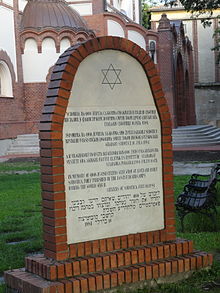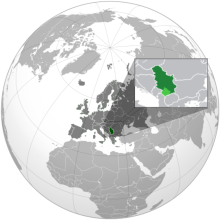
Back تاريخ اليهود في صربيا Arabic Serbiyada iudaizm Azerbaijani Geschichte der Juden in Serbien German تاریخ یهودیان در صربستان Persian Histoire des Juifs en Serbie French יהדות סרביה HE Yahudi-Serbia ID Историја на Евреите во Србија Macedonian Jevreji u Srbiji Serbo-Croatian Јевреји у Србији Serbian
 A plaque dedicated to the Jews of Subotica murdered in the Holocaust says: "In memory of the 4000 Jews with whom we lived and built Subotica together who perished in fascist death camps in World War II." | |
| Total population | |
|---|---|
| 787 (2011 census)[1] | |
| Languages | |
| Serbian, Hebrew, Ladino, and Yiddish | |
| Religion | |
| Judaism | |
| Related ethnic groups | |
| Sephardi Jews, Ashkenazi Jews, Montenegrin Jews |

| Part of a series on |
| Jews and Judaism |
|---|
The history of the Jews in Serbia is some two thousand years old. The Jews first arrived in the region during Roman times. The Jewish communities of the Balkans remained small until the late 15th century, when Jews fleeing the Spanish and Portuguese Inquisitions found refuge in the Ottoman-ruled areas, including Serbia.
The community flourished and reached a peak of 33,000, of whom almost 90% were living in Belgrade and Vojvodina, before World War II. About two-thirds of Serbian Jews were murdered in The Holocaust. After the war, most of the remaining Jewish Serbian population emigrated, chiefly to Israel.
In the 2011 census only 787 people declared themselves as Jewish. The Belgrade Synagogue continues to function as a synagogue. The renovated Subotica Synagogue, once the fourth largest synagogue building in Europe, is now mainly a cultural space, but is available for services and other religious purposes.[2] The Novi Sad Synagogue has been converted into a cultural art space.
- ^ "2011 Census of Population, Households and Dwellings in the Republic of Serbia: Population according to ethnicity – "Others" – ethnic groups with less than 2.000 members and multiple declared ethnicity" (PDF). Statistical Office of the Republic of Serbia. 2012. Archived from the original (PDF) on 17 April 2016. Retrieved 13 February 2016.
- ^ "Serbia: magnificent Subotica synagogue officially reopened". Jewish Heritage Europe. 27 March 2018.